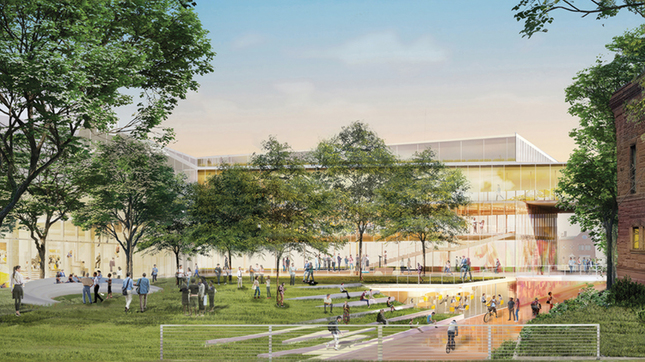
Yale University
A new quadrangle for the School of Engineering and Applied Science will occupy the site where the former Yale Health building on Hillhouse Avenue now stands.
View full image

Yale University
A new quadrangle for the School of Engineering and Applied Science will occupy the site where the former Yale Health building on Hillhouse Avenue now stands.
View full image
Last year, Yale announced that the School of Engineering and Applied Science will expand its faculty from 92 professors to more than 120. In February, the university outlined its plan to make room for them all. Over the next ten to fifteen years, Yale will build new buildings, renovate existing ones, and ultimately create a new campus for engineering on the blocks of Hillhouse Avenue between Grove and Trumbull Streets.
Engineering dean Jeffrey Brock ’92 says the plan is crucial—not just to house the new faculty, but also to attract them. Most of Yale’s existing engineering buildings are either antiquated (like Dunham and Mason Labs) or not purpose-built for engineering (like 17 Hillhouse, once home to the Yale Health Plan). Brock says the university needs more state-of-the-art facilities: “It’s about being able to recruit at the top tier and give the best faculty the facilities they need, so they will feel like Yale is a great place for them to build their careers or continue their careers.”
According to the plan developed by Weiss/Manfredi Architects, several buildings will be demolished—including 17 Hillhouse, Helen Hadley Hall, Mason Lab, and the southern portion of Dunham Lab—in order to make way for new ones. Becton Center, Dunham, Arthur K. Watson Hall, and Leet Oliver Memorial Hall will all be renovated, and a connected set of new buildings will be built on the east side of Hillhouse Avenue, surrounding a new quadrangle where 17 Hillhouse stands now.
The projects will be built in phases, likely beginning with a new building on the corner of Hillhouse and Trumbull that is now occupied by a parking lot.
Instead of organizing the space by departments, the new and renovated buildings will group labs and other facilities that do related work. “We have certain priority areas that cut across departmental boundaries,” says Brock. “For example, robotics is very much a hybrid of computer science, mechanical engineering, and even some electrical engineering and materials science. In that first new building will be faculty from four different departments, all participating in the robotics effort.”
Brock says the new buildings in particular are “about establishing an identity for the school of engineering in the 21st century. We’ll have convening spaces for students and new innovation spaces. The quad will be kind of a gathering space for the community in engineering. These are things that have been absent from the ethos of the school, and I think those are really critical for recruiting students as well as faculty.”
Provost Scott Strobel says the location of the new investment is also critical. “These buildings are right at the center of campus,” he says. “To have engineering at that center point, as opposed to being built at some remote location, is a great signal about the importance of engineering to the future of Yale.”
 loading
loading